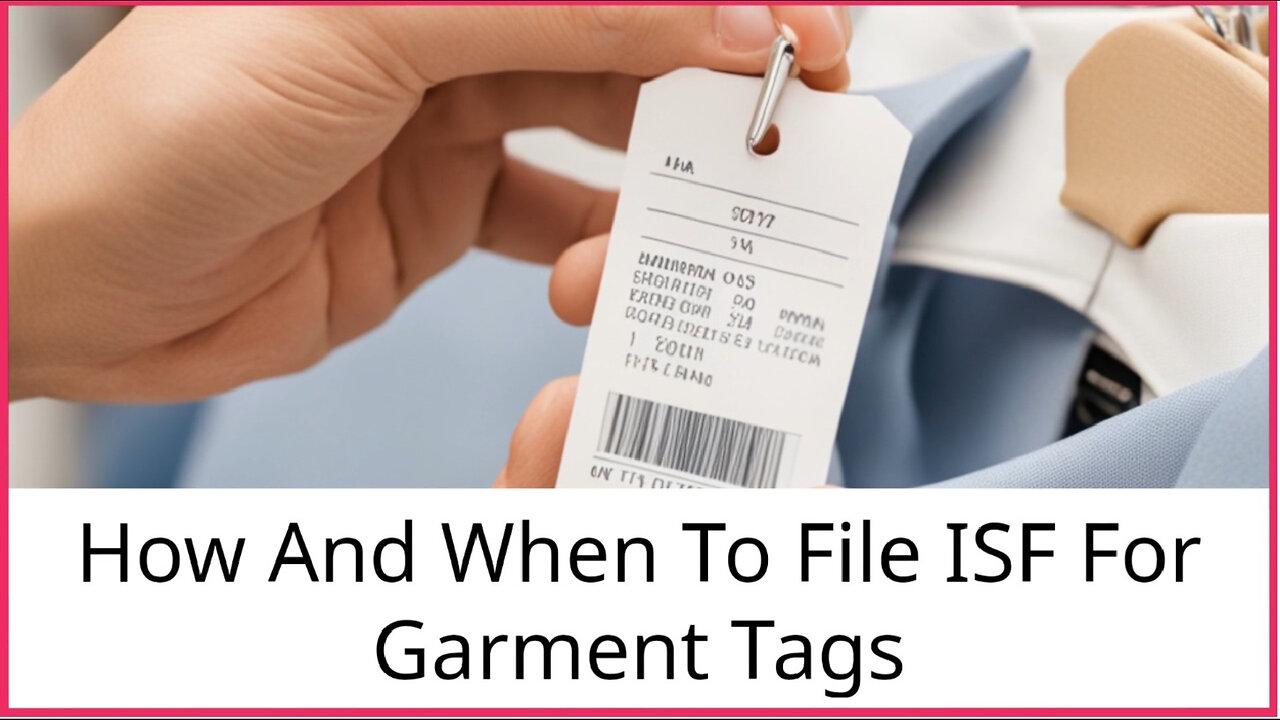Premium Only Content

Mastering the ISF Process: Filing Garment Tag ISFs with Perfect Timing!
* e-Customs Clearing
* 714-855-3556
* info@eCustomsClearing.com
* https://ecustomsclearing.com
In today's video, we deep dive into the process and timing for filing an Importer Security Filing (ISF) specifically for garment tags. We begin by explaining what an ISF is and its importance as a mandatory requirement by US Customs and Border Protection (CBP) for ocean shipments entering the United States. The ISF is an advanced electronic filing of specific data elements about the shipment that helps CBP assess and mitigate any potential security risks associated with the cargo.
Next, we discuss when and how to file an ISF for garment tags. While CBP regulations state that the ISF must be filed no later than 24 hours before the vessel's departure from the last foreign port, we recommend filing it as soon as the shipment is confirmed, preferably 5-7 days before the estimated departure date. This allows sufficient time for any necessary changes or corrections.
We then outline the essential data elements required when filing the ISF for garment tags, which include the manufacturer or supplier's name and address, the seller or owner's name and address, the buyer or owner's name and address, the ship-to party's name and address, and the container stuffing location, among others. Accuracy and timeliness in providing this information is crucial to avoid delays or penalties.
Importantly, we emphasize the consequences of not filing or inaccurately filing the ISF, which can result in significant fines and even shipment holds that can impact business operations. Hence, partnering with a knowledgeable customs broker who can guide through the filing process and ensure compliance with regulations is highly recommended.
Finally, we briefly touch upon customs bonds. In some cases, when importing goods into the United States, a customs bond may be required. Custom bonds act as financial guarantees that ensure the payment of customs duties, taxes, and fees by the importer. They offer protection to CBP in case of default by the importer and are usually obtained from a surety company, valid for one year.
To summarize, filing an ISF for garment tags is a critical step in the import process. Accurate and timely submission of information is essential for a smooth clearance of goods and to avoid complications. Following best practices such as filing the ISF in advance and collaborating with a knowledgeable customs broker will streamline the customs clearance process and prevent unnecessary delays and costs.
Thank you for watching! We hope you found this video informative, and we welcome any further questions or suggestions for future topics in the comments section. Don't forget to subscribe to our channel and enable notifications to stay updated on our upcoming videos. Until next time, happy importing!
#usimportbond #isfcustomsbroker #uscustomsclearing #isfentry
Video Disclaimer Here: This educational video is not linked to any US government entity.
00:34 - Importer Security Filing
1:02 - when and how to file an ISF for garment tags.
1:34 - Required Data Elements for ISF
2:02 - Consequences of Inaccurate Filing
2:25 - Customs Bonds
-
 23:22
23:22
MYLUNCHBREAK CHANNEL PAGE
1 day agoUnder The Necropolis - Pt 5
117K59 -
 2:26:11
2:26:11
Jewels Jones Live ®
2 days agoWINNING BIGLY | A Political Rendezvous - Ep. 108
169K50 -
 2:04:49
2:04:49
Bare Knuckle Fighting Championship
4 days agoBKFC FIGHT NIGHT MOHEGAN SUN FREE FIGHTS
91.1K7 -
 25:09
25:09
BlackDiamondGunsandGear
19 hours agoYou NEED to be Training For Whats to Come
62.9K11 -
 20:03
20:03
Sideserf Cake Studio
1 day ago $2.01 earnedA HUNGRY HUNGRY HIPPOS CAKE THAT ACTUALLY WORKS?
57.1K14 -
 23:51
23:51
marcushouse
1 day ago $2.06 earnedStarship’s Next Move Is Coming Sooner Than You Think!
42.9K7 -
 22:24
22:24
The Finance Hub
1 day ago $13.93 earnedBREAKING: JOE ROGAN JUST DROPPED A MASSIVE BOMBSHELL!!!
45.7K41 -
 55:02
55:02
PMG
21 hours ago $1.13 earnedHannah Faulkner and Miriam Shaw | Moms on A Mission
31.4K1 -
 1:21:05
1:21:05
I_Came_With_Fire_Podcast
1 day ago"Veteran Health, Military Culture, and American Exceptionalism" with Matt Kenney
96.1K21 -
 23:21
23:21
Simply Bitcoin
2 days ago $37.87 earned$1M Bitcoin in 2025? | Trump's Plan to End the Fed Revealed!
185K74